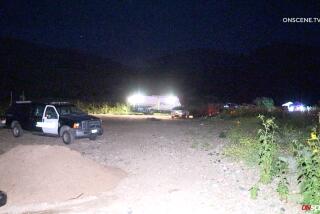Reno crash underscores safety concerns
As a state built on gambling, Nevada has been the perfect host for Reno’s National Championship Air Races, an event that has promoted the inherent risks in the daredevil sport as part of the thrill for spectators.
On the occasions when pilots were killed, boosters were quick to note that no onlookers had ever been hurt.
Now the odds have caught up with the races’ fans in the worst way, and it has become clear that the rigorous safety measures governing the competition were not enough to protect them. At least eight attendees were killed in Friday’s crash of a souped-up P-51 Mustang, along with the pilot.
Photos: Reno air-show crash kills 9
An early focus on what caused stunt pilot Jimmy Leeward, 74, to lose control of his World War II-era plane is whether a critical component of its tail assembly fell off at high speed, sending the Mustang pitching sharply upward and then plunging toward the audience.
Some experts say the planes are pushed to such limits — muscled up to exceed 500 mph — that the last-minute inspections of the aircraft at Reno and strict medical and training standards for pilots are scant hedge against disaster. And while safety concerns had stopped such races elsewhere, the 47-year-old contest has remained a popular fixture in northern Nevada.
“This is an ultra-hazardous event,” said Douglas Moss, a former Air Force test pilot who flies for United Airlines and owns a Torrance consulting firm that specializes in aircraft accident investigations. “Society has to make a decision whether or not the risk to the participants and the risk to the public are worth it.”
Moss said it appeared from photos of the disabled Mustang that its trim tab broke off from the tail elevator and that Leeward, whose head was no longer visible in the cockpit, lost consciousness when the plane shot nose-up, producing huge gravitational forces. The P-51 had been flying a qualifying heat at Reno-Stead Airport.
“It’s not common,” Moss said of a trim tab failure. He added that a pre-race inspection, no matter how thorough, might have missed a small crack in the tab.
“You can’t really see it,” he said. “It’s like a hairline fracture in a bone or tooth. But when there’s enough load or vibration, the whole thing comes apart.”
In a prepared statement, Federal Aviation Administration spokesman Ian Gregor said that officials for the agency and the event’s sponsor, the Reno Air Racing Assn., “thoroughly vet all pilots and aircraft before they are allowed to perform.”
But Gregor also said the FAA depended on the racing association’s technical experts to inspect the aircraft. “FAA inspectors review records to ensure these inspections have been done,” he said.
He said the “FAA closely examines the organization’s racecourse and proposed spectator area with the goal of ensuring that a crash or midair collision does not endanger spectators.”
A woman who answered the phone at the racing association’s office referred inquiries to the National Transportation Safety Board, which is investigating the crash.
The NTSB’s Mark Rosekind said at a news conference that investigators were looking at any role the trim tab might have played. “We’re aware of that,” Rosekind said of the images of the missing piece. “A component has been recovered in the area where that was observed.”
Before Friday’s disaster, 19 pilots had been killed in the races. Three died in 2007 alone, prompting complaints from local residents and heightened scrutiny of precautions. The following year, association President Michael Houghton was quoted by the Associated Press as saying organizers made the races as safe as possible, “but in every competition there is risk, and ours is the same. If you did away with the risk, you’d have checkers and pingpong.”
The races attract about 200,000 people over five days, pumping badly needed tourist revenue into a region hit hard by the recession and competition from California’s tribal casinos.
On Saturday, a dozen race volunteers, huddled in folding chairs and around picnic tables in an RV camp near the airfield, expressed shock at the loss of life, but said the event was crucial to the regional economy and they hoped it would return in 2012, dangers and all.
“It’s as safe as any other fast motor sport,” said Emmett Grainer, 65, a retired printer and private pilot who has been volunteering for two decades. “Accidents happen and they do everything they can to prevent them, but you can’t control everything.”
Another volunteer, Tim O’Brien, 50, said he was about 75 yards from the crash when it happened, snapping pictures that the other men were now analyzing.
“This is more an unfortunate accident than a lacking of safety,” O’Brien said.
But Mike Danko, an aviation lawyer and pilot in San Mateo, said he believed it was “just a matter of time” before spectators were killed.
He said pilots turn their aircraft into hot rods with wings, modifying them beyond their design limits for speed.
“We’re taking the gloves off — we’re trying to make this thing go as fast as possible,” he said. “If it goes out of control, there is no buffer, there is no margin, there is no way you can protect the crowd.”
This would not be the first time a trim tab snapped off a P-51 during a Reno race, Danko said. He said another Mustang shed the same part in 1998, causing the plane to soar thousands of feet. The pilot blacked out but came to in time to land safely, Danko said.
Leeward, a veteran racer and movie pilot, had described extensive aerodynamic modifications to his Mustang, named the Galloping Ghost, including shortening the wings by 10 feet, reducing the ailerons to half their original length and removing the cooling scoop from the underbelly.
If a severed trim tab turns out to be the cause, Moss said, it’s unlikely that Leeward’s age would be considered much of a contributing factor in the crash, although the consultant pointed out that the mandatory retirement age for commercial airline pilots is 65.
“With age, there is a slowdown of cognitive abilities,” he said.
Leeward had an FAA medical certificate dated March 2010 that was good for two years.
The races have enjoyed the backing of Nevada’s political heavyweights, including Senate Democratic leader Harry Reid, who joined Houghton at a news conference earlier this year to promote it.
The state’s junior senator, Republican Dean Heller, told the Associated Press on Saturday that he was reconsidering his support. “If we can’t protect spectators, I’d take a hard look at the future of the sport,” Heller said.
More to Read
Start your day right
Sign up for Essential California for news, features and recommendations from the L.A. Times and beyond in your inbox six days a week.
You may occasionally receive promotional content from the Los Angeles Times.






